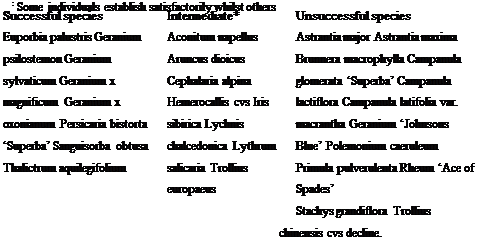As suggested in Table 6.9, this approach combines the advantages of both establishment techniques. It also complicates first-season management by creating a mix of large and small plants. Despite this, it is sometimes a useful approach, particularly where initial impact is important and where more control over appearance than is possible with seeding is necessary. Sowing is essentially used as a low-cost technique to establish seedlings in the gaps between the planted material, although inevitably these seedlings far outnumber the planted material and are likely to eventually create the long-term character of the community.
Planting into a sown vegetation dominated by meadow grasses
The author has experimented with sowing a native grass and wildflower meadow in year one, into which cultivars of native and exotic meadow plants are planted in year two (Hitchmough 2000). The resulting meadows were cut as hay in August, defoliating both planted and sown species, to maintain a diverse native meadow. The problem with this approach is that the planted material has to establish in the face of severe competition, especially from the sown native-grasses. Because of this competition, and the defoliation of the hay cut in this particular study only a few species established satisfactorily when planted into a 200 mm diameter meadow-free area or ‘gaps’. Growth of planted forbs is very slow under such conditions; even successful species tend to remain much the same size as when originally planted. Subsequent research into the next generation of these experimental hay meadows has found that by providing 450 mm gaps, the number of species that are capable of establishing, even when mown off in August, is potentially increased.
Species that establish best when planted into established, grass-dominated communities are generally those that are unpalatable to molluscs, are shade tolerant or possess leafy upright shoots (Davies et al. 2000). The provision of a gap at planting around each plant only aids long-term

Table 6.17. Establishment success of species planted into purpose-sown native meadows subject to an August haycut in Ayr, Scotland, and Harrogate, North Yorkshire (from Hitchmough 2000, and unpublished data)
establishment in species that are fundamentally well fitted to competition with grasses. Species that are not well-fitted decline as the competition-free gap around them is colonised by sown species. This is the final arbiter of what survives in a sown-planted meadow. Where gaps are maintained by weeding or herbicides beyond the first year, the plants grow much faster, however many species then decline in size as soon as this weeding ceases, resulting a year later in plants that are much the same size as they were when initially planted! Another characteristic of species planted in meadows managed by an August hay cut is that most species are dwarfed by the recurrent defoliation and subsequent crash in photosynthesis. Species that reach 1.5 m in a garden border are often no taller than 500 mm, making it very difficult to ‘design in’ emergent species. One species that seems to lie outside these biological rules is Euphorbia palustris, which continues to get bigger, even with a hay cut, after planting gaps close up.
The responses of species that have been planted into sown wildflower meadows on damp to wet soils, cut for hay in August, are given in Table 6.17. When the grassy vegetation is not mown until October, a wider range of species are able to establish, as documented by Hitchmough and Woudstra (1999). Overall species diversity may however decline under a late-cutting regime. In a three-year trial (Dunnett unpublished data), winter cutting of vigorous perennials, such as Geranium sylvaticum, G. psilostemon and Persicaria bistorta, planted into existing amenity grassland resulted in significantly
enhanced performance compared with late-summer cutting. This management regime also promoted the abundance of ‘evergreen’ native herbaceous species, such as Taraxacum officinale and Ranunculus repens.
Maintaining competition-free gaps around planted material in sown meadows is troublesome in practice, and in some situations a more satisfactory approach is to plant first and then sow over the top of these species, as previously described. The disadvantage of this approach is that if planted stock is planted close together it makes raking in of seed
|
|
|
|
6.17
(a) Creating mixed nativeexotic meadow through sowing native meadowspecies followed by gap clearance and planting cultivated species—an experiment by the author at RHS Harlow Carr; and
(b) the same experiment five years later showing how a complex finely detailed meadow vegetation has developed
slow and difficult. It also restricts the use of weedcontrol techniques for sown vegetation, such as ‘high’ mowing (Figure 6.17).





